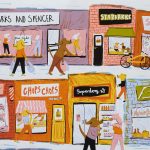
Quilting through COVID-19
We are asking students in schools to get involved with designing a 17cm x 17 cm quilt block to create a large communal quilt. Quilts can take many forms and are a great way for communities to come together to share ideas, values or commemorate events.
Quilt blocks can be sewn together to create a big ‘top’ for a quilt. We are asking contributors to send in a completed block, that we will join and back to create a large ‘communal quilt’.
The ‘Quilting through Covid-19’ project aims to allow individuals and families to share their thoughts, commemorate loved ones and raise important issues through the medium of quilt.
We want to see how your personal story plays its part within a large community of voices, come and quilt with us!
Creating your quilt block
What you will need:
- Square paper
- Pencil
- 17cm x 17cm piece of fabric
- Embroidery thread
- Scissors
- Scrap fabrics
- Ruler
- OPTIONAL scrap card
Step 1
You should begin by creating a drawing of your design on a square piece of paper.
Spend a few minutes thinking about how you have been affected by coronavirus.
It may be that you cannot do the things you like to do, that you are about to think about things differently or even that you want to share a message with someone special. Think about the ways you could communicate this message.
Begin to think about words and shapes that you could apply to your quilt block and draw a quick sketch of this. This will help you to think through your ideas, and to finalise your design. It will also act as a point of reference for later on.
Step 2
You should have a 17cm x 17cm square of fabric to work with, this is your ‘block’. Remember the outer 1cm edge of the block won’t be seen as it is seam allowance.
You can mark this section with a ruler and pencil so that you remember, and your design should stay within the 15 x 15cm square in the middle.
You might like to think about using a fabric that is personal to you to make your block more personal, but this should be a lightweight fabric.
You should then begin to look at your design or words and look at which elements are thin lines and which elements are blocks of colour.
Applique should be used for the blocks of colour and embroidery should be used for lines.
Now decide which parts of your design should be stitched/embroidered and which bits should be applique.
Embroidery Technique
There are four simple techniques on the diagram below to help you embroider.
You will need a strand of embroidery thread about 100cm long, and a needle. Thread the needle with the embroidery thread and tie a knot in one of the ends.
Using a pencil, draw your design onto your block, remember you can use your drawing from step one to help you.
Make sure your design doesn’t go over the 1cm seam allowance. Push your threaded needle from the back to the front of the fabric and use one of the stitches below to follow your lines.
When your thread starts to get too short to sew with, you will need to make sure the needle and thread are pushed through to the back of your work (the side that people won’t see). You will then need to tie the excess string off.
Applique Technique
Applique means to apply fabric shapes onto another piece of fabric.
This can be done by stitching the fabric shape onto your block.
Instructions
Cut the shape you would like out of the fabric of your choice… remember to keep your block fabric whole! Sometimes if you are repeating the same shape it is useful to use a template to draw round. This can be made from card (a cereal box works well!)
Place onto your backing fabric in the correct position, this is where it is useful to use your drawing from step 1.
You can then stitch the shape into the correct place. You can use the running stitch from the embroidery section to do this, or you can experiment. You can use a safety pin to hold your shape in place while you stitch around the edges.
Send your quilt block to:
Quilting Through Covid-19
Norwich University of the Arts
Francis House
3-7 Redwell Street
Norwich
NR2 4SN
United Kingdom
For queries, please email studentrecruitment@norwichuni.ac.uk
How quilting has brought communities together
In 1987 Cleve Jones asked people to write the names of loved ones who had been lost onto signs that were fixed to the federal building in San Francisco.
These began to look like a quilt which prompted Jones to create the NAMES Project AIDS Memorial Quilt.
The goal of this Quilt is to bring awareness to how massive the AIDS pandemic really was, and to bring support and healing to those affected by it. The quilt commemorated many people who were lost due to AIDs related complications.
In addition, the Amish communities of America often come together in groups to work on quilts at one time often called ‘quilting bees’. These are often seen as events in their own rights, often involving dancing once the quilting is done.
This is an essential part of Amish life, and allows essential work to be done, but also to communicate and collaborate with other members of the community.
Instagram artist Bisa Butler produces brightly coloured compositions that reflect their subject’s stories that may have been forgotten through time.
The fabrics that Butler chooses often reflect the stories she wants to tell. You can use fabrics that are important to you to make your piece more personal!